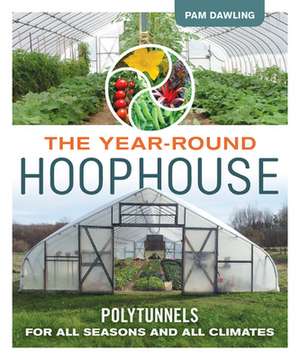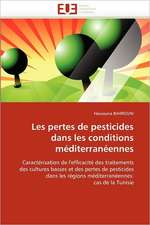The Year-Round Hoophouse
Autor Pam Dawlingen Limba Engleză Paperback – 6 dec 2018
Design and build a hoophouse or polytunnel, and grow abundant produce year-round in any climate
I can think of no better introduction to the world of protected growing. -Andrew Mefferd, publisher, Growing for Market
Growing in hoophouses - also known as high tunnels or polytunnels - reduces the impact of an increasingly unpredictable climate on crops, mitigates soil erosion, extends the growing season and keeps leafy greens alive through the winter, enablling growers to supply more regional food needs.
With The Year-Round Hoophouse, best-selling author Pam Dawling brings a comprehensive guide to designing and building a hoophouse and making a success of growing abundant, delicious fresh produce all year, whatever your climate and land size. Chapters include:
- Hoophouse siting, size, style, frame construction, and tools
- Bed layout, soil, crop rotations, and extensive coverage of various crops for all seasons
- Organic solutions to pests and diseases
- Disaster preparation
- Tested resources for each chapter.
The Year-Round Hoophouse is ideal for growers who wish to move into protected growing, as well as beginners in both rural and urban spaces. It is an essential reference resource for professors and students of courses in sustainable agriculture, and for interns and apprentices learning on the job.
... a must-read for anyone looking to enhance the resilience of their garden or farm. -Laura Lengnick, author, Resilient Agriculture
Pam's experience in high tunnel growing really shows in her details on crop production. Overall, a great addition to any farm family's library. -Chris Mullins, Extension Specialist, Greenhouse and Specialty Crops, Virginia State University
Pam Dawling has been farming and providing training in sustainable vegetable production in a large variety of climates for over 40 years. She writes and speaks widel, including weekly at sustainablemarketfarming.com and monthly on the Mother Earth News Organic Gardening Blog, and is a contributing editor with Growing for Market magazine. For 25 years Pam was the manager of Twin Oaks community farm in Virginia, which feeds the 100 community members year-round. Pam is also the author of the best-selling Sustainable Market Farming. She lives and grows at Twin Oaks in Louisa, Virginia.
Preț: 202.13 lei
Nou
38.68€ • 40.47$ • 32.13£
Carte disponibilă
Livrare economică 13-27 martie
Specificații
ISBN-10: 0865718636
Pagini: 288
Dimensiuni: 254 x 203 x 19 mm
Greutate: 0.73 kg
Editura: New Society Publishers
Notă biografică
Pam Dawling has been farming and providing training in sustainable vegetable production in a large variety of climates for over 40 years, 14 of which have been hoophouse growing. Pam's first book is the best-selling Sustainable Market Farming: Intensive Vegetable Production on a Few Acres. Pam is a contributing editor with Growing for Market magazine, has written articles and information sheets for various biological farming publications, and is a popular speaker on growing vegetables at sustainable agriculture conferences and events each year. She blogs weekly at sustainablemarketfarming.com and monthly on the Mother Earth News Organic Gardening Blog. Pam does consultancy work for new and beginning farmers, and for 25 years was the manager of Twin Oaks community farm in Virginia, which feeds the 100 community members year-round. She lives and grows at Twin Oaks in Louisa, Virginia.
Cuprins
Foreword
Acknowledgments
Introduction
Part I: Design, Siting and Construction
1. Hoophouse Siting and Planning
2. Style and Design
3. Shopping Checklist
4. Preparing the Site and the Base
5. Utilities
6. Frame Assembly, Baseboards and Hipboards
7. End Walls
8. Roof Plastic
9. Drip Irrigation and Outfitting Your Hoophouse
Part II: Growing Crops
10. Lettuce
11. Other Salad Greens
12. Cooking Greens
13. Root Crops
14. Alliums
15. Legumes
16. Tomatoes
17. Peppers and Eggplants
18. Cucurbits
19. Crops for High Summer
20. Bare-Root Transplants
21. Seed Crops
Part III: Keeping Everything Working Well
22. Planning and Record-Keeping
23. Cold Weather Care
24. Hot Weather Care
25. Succession Crops
26. Crop Rotations and Sequences
27. Pests and Diseases
28. Salt Build-Up
29. Feeding the Soil
30. Replacing the Plastic
31. Preparing for and Coping with Disasters
Resources
Index
About the Author
About New Society Publishers













